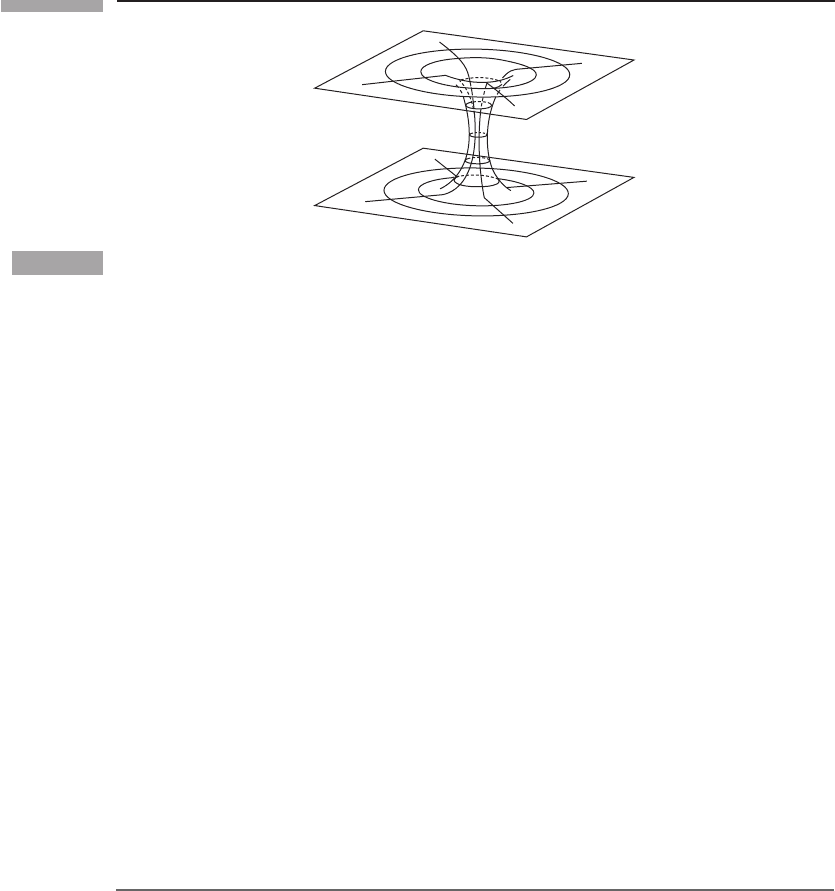Schutz B. A first course in general relativity
Подождите немного. Документ загружается.


253 9.7 Exercises
t
31 Calculate the quadrupole tensor I
jk
and its traceless counterpart I
–
jk
(Eq. (9.87)) for the
following mass distributions.
(a) A spherical star where density is ρ(r, t). Take the origin of the coordinates in
Eq. (9.82) to be the center of the star.
(b) The star in (a), but with the origin of the coordinates at an arbitrary point.
(c) An ellipsoid of uniform density ρ and semiaxes of length a, b, c oriented along the
x, y, and z axes respectively. Take the origin to be at the center of the ellipsoid.
(d) The ellipsoid in (c), but rotating about the z axis with angular velocity ω.
(e) Four masses m located respectively at the points (a,0,0),(0,a,0), (−a,0,0),
(0, −a,0).
(f) The masses as in (e), but all moving counter-clockwise about the z axis on a circle
of radius a with angular velocity ω.
(g) Two masses m connected by a massless spring, each oscillating on the x axis with
angular frequency ω and amplitude A about mean equilibrium positions a distance
l
0
apart, keeping their center of mass fixed.
(h) Unequal masses m and M connected by a spring of spring constant k and equilib-
rium length l
0
, oscillating (with their center of mass fixed) at the natural frequency
of the system, with amplitude 2A (this is the total stretching of the spring). Their
separation is along the x axis.
32 This exercise develops the TT gauge for spherical waves.
(a) In order to transform Eq. (9.83) to the TT gauge, use a gauge transformation gen-
erated by a vector ξ
α
= B
α
(x
μ
)e
i(r−t)
/r, where B
α
is a slowly varying function of
x
μ
. Find the general transformation law to order 1/r.
(b) Demand that the new
¯
h
αβ
satisfy three conditions to order 1/r:
¯
h
0μ
= 0,
¯
h
α
α
= 0,
and
¯
h
μj
n
j
= 0, where n
j
:= x
j
/r is the unit vector in the radial direction. Show that
it is possible to find functions B
α
, which accomplish such a transformation and
which satisfy ξ
α
= 0 to order 1/r.
(c) Show that Eqs. (9.84)–(9.87) hold in the TT gauge.
(d) By expanding R in Eq. (9.103) but discarding r
−1
terms, show that the higher-order
parts of
¯
h
0μ
that are not eliminated by Eq. (9.104) are gauge terms to order v
2
, i.e.
up to second time derivatives in the expansion of
¯
h
00
and first time derivatives in
¯
h
0j
in Eq. (9.103).
33 (a) Let n
j
be a unit vector in three-dimensional Euclidean space. Show that P
j
k
= δ
j
k
−
n
j
n
k
is the projection tensor orthogonal to n
j
, i.e. show that for any vector V
j
,(i)
P
j
k
V
k
is orthogonal to n
j
, and (ii) P
j
k
P
k
l
V
l
= P
j
k
V
k
.
(b) Show that the TT gauge
¯
h
TT
ij
of Eqs. (9.84)–(9.86) is related to the original
¯
h
kl
of
Eq. (9.83)by
¯
h
TT
ij
= P
k
i
P
l
j
¯
h
kl
−
1
2
P
ij
(P
kl
¯
h
kl
), (9.163)
where n
j
points in the z direction.
34 Show that I
–
jk
is trace free, i.e. I
–
l
l
= 0.
35 For the systems described in Exer. 31, calculate the transverse-traceless quadrupole
radiation field, Eqs. (9.85)–(9.86)or(9.163), along the x, y, and z axes. In Eqs. (9.85)–
(9.86) be sure to change the indices appropriately when doing the calculation on the x
and y axes, as in the discussion leading to Eq. (9.91).

254 Gravitational radiation
t
36 Use Eq. (9.163) or a rotation of the axes in Eqs. (9.85)–(9.86) to calculate the amplitude
and orientation of the polarization ellipse of the radiation from the simple oscillator,
Eq. (9.88), traveling at an angle θ to the x axis.
37 The ω and 2ω terms in Eq. (9.93) are qualitatively different, in that the 2ω term depends
only on the amplitude of oscillator A, while the ω term depends on both A and the
separation of the masses l
0
. Why should l
0
be involved – the masses don’t move over
that distance? The answer is that stresses are transmitted over that distance by the
spring, and stresses cause the radiation. To see this, do an analogous calculation for
a similar system, in which stresses are not passed over large distances. Consider a
system consisting of two pairs of masses. Each pair has one particle of mass m and
another of mass M m. The masses within each pair are connected by a short spring
whose natural frequency is ω. The pairs’ centers of mass are at rest relative to one
another. The springs oscillate with equal amplitude in such a way that each mass m
oscillates sinusoidally with amplitude A, and the centers of oscillation of the masses
are separated by l
0
A. The masses oscillate out of phase. Use the calculation of
Exer. 31(h) to show that the radiation field of the system is Eq. (9.93) without the ω
term. The difference between this system and that in Eq. (9.93) may be thought to be
the origin of the stresses to maintain the motion of the masses m.
38 Do the same as Exer. 36 for the binary system, Eqs. (9.98)–(9.99), but instead of finding
the orientation of the linear polarization, find the orientation of the ellipse of elliptical
polarization.
39 Let two spherical stars of mass m and M be in elliptical orbit about one another in
the x −y plane. Let the orbit be characterized by its total energy E and its angular
momentum L.
(a) Use Newtonian gravity to calculate the equation of the orbits of both masses about
their center of mass. Express the orbital period P, minimum separation a, and
eccentricity e as functions of E and L.
(b) Calculate I
–
kj
for this system.
(c) Calculate from Eq. (9.106) the TT radiation field along the x and z axes. Show that
your result reduces to Eqs. (9.98)–(9.99) when m = M and the orbits are circular.
40 Show from Eq. (9.101) that spherically symmetric motions produce no gravitational
radiation.
41 Derive Eq. (9.115)fromEq.(9.114) in the manner suggested in the text.
42 (a) Derive Eq. (9.116).
(b) Derive Eqs. (9.117) and (9.118) by superposing Eqs. (9.107) and (9.116) and
assuming R is small.
(c) Derive Eq. (9.120) in the indicated manner.
43 Show that if we define an averaged stress–energy tensor for the waves
T
αβ
=
¯
h
TT
μν,α
¯
h
TTμν
,β
/32π (9.164)
(where denotes an average over both one period of oscillation in time and one
wavelength of distance in all spatial directions), then the flux F of Eq. (9.122)isthe
component T
0z
for that wave. A more detailed argument shows that Eq. (9.164) can in
fact be regarded as the stress–energy tensor of any wave packet, provided the averages

255 9.7 Exercises
t
are defined suitably. This is called the Isaacson stress–energy tensor. See Misner et al.
(1973) for details.
44 (a) Derive Eq. (9.125)fromEq.(9.123).
(b) Justify Eq. (9.127)fromEq.(9.125).
(c) Derive Eq. (9.127)fromEq.(9.122) using Exer. 33(b).
45 (a) Consider the integral in Eq. (9.128). We shall do it by the following method.
(i) Argue on grounds of symmetry that
n
j
n
k
sin θ dθ dφ must be proportional
to δ
jk
. (ii) Evaluate the constant of proportionality by explicitly doing the case
j = k = z.
(b) Follow the same method for Eq. (9.129). In (i) argue that the integral can depend
only on δ
ij
, and show that the given tensor is the only one constructed purely from
δ
ij
that has the symmetry of being unchanged when the values of any two of its
indices are exchanged.
46 Derive Eqs. (9.130) and (9.131), remembering Eq. (9.124) and the fact that I
–
ij
is
symmetric.
47 (a) Recall that the angular momentum of a particle is p
φ
. It follows that the angular
momentum flux of a continuous system across a surface x
i
= const. is T
iφ
. Use this
and Exer. 43 to show that the total z component of angular momentum radiated by
a source of gravitational waves (which is the integral over a sphere of large radius
of T
rφ
in Eq. (9.164)) is
F
J
=−
2
5
(
¨
I
xl
...
I
y
l
−
¨
I
yl
...
I
x
l
). (9.165)
(b) Show that if
¯
h
TT
μν
depends on t and φ only as cos(t − mφ), then the ratio of the
total energy radiated to the total angular momentum radiated is /m.
48 Calculate Eq. (9.135).
49 For the arbitrary binary system of Exer. 39:
(a) Show that the average energy loss rate over one orbit is
dE/dt=−
32
5
μ
2
(m + M)
3
a
5
(1 − e
2
)
7/2
1 +
73
24
e
2
+
37
96
e
4
(9.166)
and from the result of Exer. 47(a)
dL/dt=−
32
5
μ
2
(m + M)
5/2
a
7/2
(1 − e
2
)
7/2
1 +
7
8
e
2
, (9.167)
where μ = mM/(m +M) is the reduced mass.
(b) Show that
da/dt=−
64
5
μ(m + M)
2
a
3
(1 − e
2
)
7/2
1 +
73
24
e
2
+
37
96
e
4
, (9.168)
de/dt=−
304
15
μ(m + M)
2
e
a
4
(1 − e
2
)
5/2
1 +
121
304
e
2
, (9.169)
dP/dt=−
192π
5
μ(m + M)
3/2
a
5/2
(1 − e
2
)
7/2
1 +
73
24
e
2
+
37
96
e
4
. (9.170)
(c) Verify Eq. (9.144).
(Do parts (b) and (c) even if you can’t do (a).) These were originally derived by Peters
(1964).

10
Spherical solutions for stars
10.1 C oo rd i na te s f or spherically symmetric
spacetimes
For our first study of strong gravitational fields in GR, we will consider spherically sym-
metric systems. They are reasonably simple, yet physically very important, since very
many astrophysical objects appear to be nearly spherical. We begin by choosing the
coordinate system to reflect the assumed symmetry.
Flat space in spherical coordinates
By defining the usual coordinates (r, θ , φ), the line element of Minkowski space can be
written
ds
2
=−dt
2
+ dr
2
+ r
2
(dθ
2
+ sin
2
θ dφ
2
). (10.1)
Each surface of constant r and t is a sphere or, more precisely, a two-sphere–atwo-
dimensional spherical surface. Distances along curves confined to such a sphere are given
by the above equation with dt = dr = 0:
dl
2
= r
2
(dθ
2
+ sin
2
θ dφ
2
):= r
2
d
2
, (10.2)
which defines the symbol d
2
for the element of solid angle. We note that such a sphere
has circumference 2π r and area 4π r
2
, i.e. 2π times the square root of the coefficient of
d
2
and 4π times the coefficient of d
2
respectively. Conversely, any two-surface where
the line element is Eq. (10.2) with r
2
independent of θ and φ has the intrinsic geometry of
a two-sphere.
Two-spheres in a curved spacetime
The statement that a spacetime is spherically symmetric can now be made more precise: it
implies that every point of spacetime is on a two-surface which is a two-sphere, i.e. whose
line element is
dl
2
= f (r
, t)(dθ
2
+ sin
2
θ dφ
2
), (10.3)
where f (r
, t) is an unknown function of the two other coordinates of our manifold r
and
t. The area of each sphere is 4π f (r
, t). We define the radial coordinate r of our spherical

257 10.1 Coordinates for spherically symmetric spacetimes
t
t
Figure 10.1
Two plane sheets connected by a circular throat: there is circular (axial) symmetry, but the center
of any circle is not in the two-space.
geometry such that f (r
, t):= r
2
. This represents a coordinate transformation from (r
, t)
to (r, t). Then any surface r = const., t = const. is a two-sphere of area 4πr
2
and circum-
ference 2π r. This coordinate r is called the ‘curvature coordinate’ or ‘area coordinate’
because it defines the radius of curvature and area of the spheres. There is noapriorirela-
tion between r and the proper distance from the center of the sphere to its surface. This r
is defined only by the properties of the spheres themselves. Since their ‘centers’ (at r = 0
in flat space) are not points on the spheres themselves, the statement that a spacetime is
spherically symmetric does not require even that there be a point at the center. A simple
counter-example of a two-space in which there are circles but no point at the center of
them is in Fig. 10.1. The space consists of two sheets, which are joined by a ‘throat’. The
whole thing is symmetric about an axis along the middle of the throat, but the points on this
axis – which are the ‘centers’ of the circles – are not part of the two-dimensional surface
illustrated. Yet if φ is an angle about the axis, the line element on each circle is just r
2
dφ
2
,
where r is a constant labeling each circle. This r is the same sort of coordinate that we use
in our spherically symmetric spacetime.
Meshing the two-spheres into a three-space for t = const
Consider the spheres at r and r +d r. Each has a coordinate system (θ, φ),butuptonow
we have not required any relation between them. That is, we could conceive of having the
pole for the sphere at r in one orientation, while that for r + d r was in another. The sensible
thing is to say that a line of θ = const., φ = const. is orthogonal to the two-spheres. Such
a line has, by definition, a tangent e
r
. Since the vectors e
θ
and e
φ
lie in the spheres, we
require e
r
·e
θ
=e
r
·e
φ
= 0. This means g
rθ
= g
rφ
= 0 (recall Eqs. (3.3) and (3.21)). This
is a definition of the coordinates, allowed by spherical symmetry. We thus have restricted
themetrictotheform
ds
2
= g
00
dt
2
+ 2g
0r
dr dt + 2g
0θ
dθ dt + 2g
0φ
dφ dt +g
rr
dr
2
+ r
2
d
2
. (10.4)

258 Spherical solutions for stars
t
Spherically symmetric spacetime
Since not only the spaces t = const. are spherically symmetric, but also the whole space-
time, we must have that a line r = const., θ = const., φ = const. is also orthogonal to the
two-spheres. Otherwise there would be a preferred direction in space. This means that e
t
is
orthogonal to e
θ
and e
φ
,org
tθ
= g
tφ
= 0. So now we have
ds
2
= g
00
dt
2
+ 2g
0r
dr dt + g
rr
dr
2
+ r
2
d
2
. (10.5)
This is the general metric of a spherically symmetric spacetime, where g
00
, g
0r
, and g
rr
are functions of r and t. We have used our coordinate freedom to reduce it to the simplest
possible form.
10.2 Static spherically symmetric spacetimes
The metric
Clearly, the simplest physical situation we can describe is a quiescent star or black hole – a
static system. We define a static spacetime to be one in which we can find a time coordinate
t with two properties: (i) all metric components are independent of t, and (ii) the geometry
is unchanged by time reversal, t →−t. The second condition means that a film made of
the situation looks the same when run backwards. This is not logically implied by (i), as
the example of a rotating star makes clear: time reversal changes the sense of rotation, but
the metric components will be constant in time. (A spacetime with property (i) but not
necessarily (ii) is said to be stationary.)
Condition (ii) has the following implication. The coordinate transformation (t, r, θ , φ) →
(−t, r, θ, φ) has
¯
0
0
=−1,
i
j
= δ
i
j
, and we find
g
¯
0
¯
0
= (
0
¯
0
)
2
g
00
= g
00
,
g
¯
0¯r
=
0
¯
0
r
¯r
g
0r
=−g
0r
,
g
¯r¯r
= (
r
¯r
)
2
g
rr
= g
rr
.
⎫
⎬
⎭
(10.6)
Since the geometry must be unchanged (i.e. since g
¯α
¯
β
= g
αβ
), we must have g
0r
≡ 0. Thus,
the metric of a static, spherically symmetric spacetime is
ds
2
=−e
2
dt
2
+ e
2
dr
2
+ r
2
d
2
, (10.7)
where we have introduced (r) and (r) in place of the two unknowns g
00
(r) and g
rr
(r).
This replacement is acceptable provided g
00
< 0 and g
rr
> 0 everywhere. We shall see
below that these conditions do hold inside stars, but they break down for black holes.
When we study black holes in the next chapter we shall have to look carefully again at our
coordinate system.

259 10.2 Static spherically symmetric spacetimes
t
If we are interested in stars, which are bounded systems, we are entitled to demand that,
far from the star, spacetime is essentially flat. This means that we can impose the following
boundary conditions (or asymptotic regularity conditions) on Einstein’s equations:
lim
r→∞
(r) = lim
r→∞
(r) = 0. (10.8)
With this condition we say that spacetime is asymptotically flat.
Physical interpretation of metric terms
Since we have constructed our coordinates to reflect the physical symmetries of the space-
time, the metric components have useful physical significance. The proper radial distance
from any radius r
1
to another radius r
2
is
l
12
=
'
r
2
r
1
e
dr, (10.9)
since the curve is one on which dt = dθ = dφ = 0. More important is the significance
of g
00
. Since the metric is independent of t, we know from Ch. 7 that any particle fol-
lowing a geodesic has constant momentum component p
0
, which we can define to be the
constant −E:
p
0
:=−E. (10.10)
But a local inertial observer at rest (momentarily) at any radius r of the spacetime mea-
sures a different energy. Her four-velocity must have U
i
= d x
i
/d τ = 0 (since she is
momentarily at rest), and the condition
U ·
U = 1 implies U
0
= e
−
. The energy she
measures is
E
∗
=−
U ·p = e
−
E. (10.11)
We therefore have found that a particle whose geodesic is characterized by the constant
E has energy e
−
E relative to a locally inertial observer at rest in the spacetime. Since
e
−
= 1 far away, we see that E is the energy a distant observer would measure if the
particle gets far away. We call it the energy at infinity. Since e
−
> 1 everywhere else (this
will be clear later), we see that the particle has larger energy relative to inertial observers
that it passes elsewhere. This extra energy is just the kinetic energy it gains by falling in a
gravitational field. The energy is studied in more detail in Exer. 3, § 10.9.
This is particularly significant for photons. Consider a photon emitted at radius r
1
and
received very far away. If its frequency in the local inertial frame is ν
em
(which would be
determined by the process emitting it, e.g. a spectral line), then its local energy is hν
em
(h being Planck’s constant) and its conserved constant E is hν
em
exp [(r
1
)]. When it
reaches the distant observer it is measured to have energy E, and hence frequency E/h ≡
ν
rec
= ν
em
exp [(r
1
)]. The redshift of the photon, defined by
z =
λ
rec
− λ
em
λ
em
=
ν
em
ν
rec
− 1, (10.12)

260 Spherical solutions for stars
t
is therefore
z = e
−(r
1
)
− 1. (10.13)
This important equation attaches physical significance to e
. (Compare this calculation
with the one in Ch. 2.)
The Einstein tensor
We can show that for the metric given by Eq. (10.7), the Einstein tensor has components
G
00
=
1
r
2
e
2
d
dr
[r(1 −e
−2
)], (10.14)
G
rr
=−
1
r
2
e
2
(1 − e
−2
) +
2
r
, (10.15)
G
θθ
= r
2
e
−2
[
+ (
)
2
+
/r −
−
/r], (10.16)
G
φφ
= sin
2
θG
θθ
, (10.17)
where
:= d/dr, etc. All other components vanish.
10.3 S t at ic p e rf ec t fl u id E i ns te i n e q ua t io n s
Stress–energy tensor
We are interested in static stars, in which the fluid has no motion. The only nonzero
component of
U is therefore U
0
. What is more, the normalization condition
U ·
U =−1 (10.18)
implies, as we have seen before,
U
0
= e
−
, U
0
=−e
. (10.19)
Then T has components given by Eq. (4.38):
T
00
= ρ e
2
, (10.20)
T
rr
= p e
2
, (10.21)
T
θθ
= r
2
p, (10.22)
T
φφ
= sin
2
θ T
θθ
. (10.23)
All other components vanish.

261 10.3 Static perfect fluid Einstein equations
t
Equation of state
The stress–energy tensor involves both p and ρ, but these may be related by an equation of
state. For a simple fluid in local thermodynamic equilibrium, there always exists a relation
of the form
p = p(ρ, S), (10.24)
which gives the pressure p in terms of the energy density ρ and specific entropy S.Weoften
deal with situations in which the entropy can be considered to be a constant (in particular,
negligibly small), so that we have a relation
p = p(ρ). (10.25)
These relations will of course have different functional forms for different fluids. We will
suppose that some such relation always exists.
Equations of motion
The conservation laws are (Eq. (7.6))
T
αβ
;β
= 0. (10.26)
These are four equations, one for each value of the free index α. Because of the symmetries,
only one of these does not vanish identically: the one for which α = r.Itimplies
(ρ +p)
d
dr
=−
dp
dr
. (10.27)
This is the equation that tells us what pressure gradient is needed to keep the fluid static in
the gravitational field, the effect of which depends on d/dr.
Einstein equations
The (0, 0) component of Einstein’s equations can be found from Eqs. (10.14) and (10.20).
It is convenient at this point to replace (r) with a different unknown function m(r)
defined as
m(r):=
1
2
r(1 −e
−2
), (10.28)

262 Spherical solutions for stars
t
or
g
rr
= e
2
=
1 −
2m(r)
r
−1
. (10.29)
Then the (0,0) equation implies
dm(r)
dr
= 4π r
2
ρ. (10.30)
This has the same form as the Newtonian equation, which calls m(r) the mass inside the
sphere of radius r. Therefore, in relativity we call m(r) the mass function, but it cannot be
interpreted as the mass energy inside r since total energy is not localizable in GR. We shall
explore the Newtonian analogy in § 10.5 below.
The (r, r) equation, from Eqs. (10.15) and (10.21), can be cast in the form
d
dr
=
m(r) +4π r
3
p
r[r − 2m(r)]
. (10.31)
If we have an equation of state of the form Eq. (10.25), then Eqs. (10.25), (10.27), (10.30),
and (10.31) are four equations for the four unknowns , m, ρ, p. If the more general equa-
tion of state, Eq. (10.24), is needed, then S is a completely arbitrary function. There is no
additional information contributed by the (θ, θ ) and (φ, φ) Einstein equation, because (i) it
is clear from Eqs. (10.16), (10.17), (10.22), and (10.23) that the two equations are essen-
tially the same, and (ii) the Bianchi identities ensure that this equation is a consequence of
Eqs. (10.26), (10.30), and (10.31).
10.4 T h e ex te rio r g eo m et r y
Schwarzschild metric
In the region outside the star, we have ρ = p = 0, and we get the two equations
dm
dr
= 0, (10.32)
d
dr
=
m
r(r − 2m)
. (10.33)
